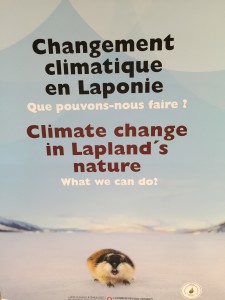By Dr. Adam Fenech
 I am in Paris this week for the climate conference seen as the last “do or die” chance at getting the world’s greenhouse gas emissions under control to limit the human increase in global average temperature to 2°C, above which is considered a “dangerous” level. Presently, 184 countries have submitted their intended plans for greenhouse gas reductions with the country of Angola being the latest. Canada tabled their intentions back on May 15 of this year under the former Canadian Government of Stephen Harper’s Conservatives. The Harper government provided Canada’s intention to achieve an economy-wide target to reduce our greenhouse gas emissions by 30% below 2005 levels by 2030. Canada pointed to its stringent coal fired electricity standards that ban the construction of traditional coal-fired electricity generation units, and that accelerate the phase-out of existing coal-fired electricity generation units. Canada also noted action in the transportation sector by working closely with the United States towards common North American greenhouse gas standards for vehicles. As an example, 2025 model year passenger vehicles and light trucks are expected to emit about half as many greenhouse gases as 2008 models. Canada announced its intentions to regulate hydrofluorocarbons (HFCs), the fastest growing greenhouse gas globally; to develop regulations to address methane emissions from the oil and gas sector; as well as to reduce greenhouse gas emissions from natural gas fired electricity, chemicals and nitrogen fertilizers through what it called Canada’s “responsible sector-by-sector regulatory approach that ensures Canada’s economic competitiveness is protected.”
I am in Paris this week for the climate conference seen as the last “do or die” chance at getting the world’s greenhouse gas emissions under control to limit the human increase in global average temperature to 2°C, above which is considered a “dangerous” level. Presently, 184 countries have submitted their intended plans for greenhouse gas reductions with the country of Angola being the latest. Canada tabled their intentions back on May 15 of this year under the former Canadian Government of Stephen Harper’s Conservatives. The Harper government provided Canada’s intention to achieve an economy-wide target to reduce our greenhouse gas emissions by 30% below 2005 levels by 2030. Canada pointed to its stringent coal fired electricity standards that ban the construction of traditional coal-fired electricity generation units, and that accelerate the phase-out of existing coal-fired electricity generation units. Canada also noted action in the transportation sector by working closely with the United States towards common North American greenhouse gas standards for vehicles. As an example, 2025 model year passenger vehicles and light trucks are expected to emit about half as many greenhouse gases as 2008 models. Canada announced its intentions to regulate hydrofluorocarbons (HFCs), the fastest growing greenhouse gas globally; to develop regulations to address methane emissions from the oil and gas sector; as well as to reduce greenhouse gas emissions from natural gas fired electricity, chemicals and nitrogen fertilizers through what it called Canada’s “responsible sector-by-sector regulatory approach that ensures Canada’s economic competitiveness is protected.”
But under a new Canadian Government led by Justin Trudeau’s Liberals, Canada won’t be arriving in Paris with any new targets to cut emissions further. That won’t happen until after the Paris climate talks, when premiers and territorial leaders meet to negotiate a new national approach to climate change. Instead, Canada announced at the Commonwealth Heads of Government meeting in Malta last week a contribution of $2.65 billion over the next five years towards an international climate fund to help developing countries fight climate change.
In March of this year, I was part of a group of over 6o Canadian scholars from universities across the country in disciplines ranging from engineering to social sciences that calls itself the Sustainable Canada Dialogues. The group, led by Catherine Potvin of McGill University, produced a consensus on science-based, viable solutions for greenhouse gas reduction. The report provides 10 policies that can kick-start Canada’s transition toward a low-carbon economy and sustainable society. We highlighted the opportunities, for jobs and the economy, stemming from actively pursuing low-carbon electricity, evolving smart urban design, creating participatory and open governance institutions and rising to the challenge of something tantamount to a total transportation revolution.
Two key policy orientations stand out: there needs to be a price on carbon now throughout Canada, and I wrote about carbon taxes and cap-and-trade systems earlier. Some mixture of both approaches might be the way forward. The second one is to ensure electric connections between the provinces that produce hydro-electricity and those that do not. Such an interconnection would allow Canada to have 100% carbon free electricity and could become the backbone of our transition to a low carbon sustainable society.
The group proposes that the “problem” of climate change should be viewed as an “opportunity for change” that will improve the well-being of all Canadians. For us, sustainability entails a vision of the future that improves social and environmental well-being. Seen in this context, climate change policy should promote a transition to a new state, similar to the transition that occurred during industrialization. We hope that Canada will be up to the expectations. For the present and future generations, the time is now ripe to initiate ambitious greenhouse gas emission reduction efforts.

